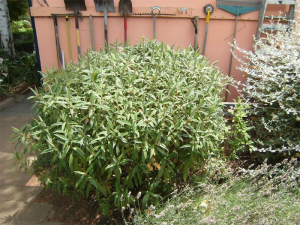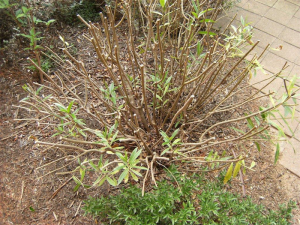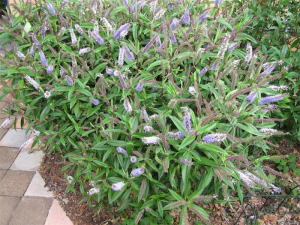HEBES are native to NZ, are remarkably tough and ideally suited to Canberra gardens and our extremes of climate.

They can be pruned now, following my recommendation of cutting off only one third at any one time. However, they’ll respond to more drastic treatment and will tolerate heavier pruning than many other shrubs if they’re old and neglected.
If you have any of the ever-so-sad specimens, get out the secateurs and give them a new lease of life. Don’t forget to provide a good feed with organic plant food to help them recover after their drastic haircut.

The first picture (1) shows a hebe about five years ago, since then it doubled in size. You-know-who had planted it too close to the path. The next picture (2) shows the plant with a drastic haircut. After that I reduced it by half again without a leaf left on the shrub.

The third picture (3) shows the same hebe six months later full of flower and vigour.
I planted this hebe in a group of three about 10 years ago and admit to not recalling its name.
Hebes make excellent container plants if you have limited space in your garden or on a balcony.
IN the definitive work “Hebes – a Guide to Species, Hybrids and Allied Genera” (Timber Press, 2006) by possibly the world’s expert on these shrubs, author Lawrie Metcalf lists more than 500 hebes. And many more have been bred since the publication of that book.
HEBE species, representing NZ’s Anzac role, are planted down the raised centre beds along Anzac Parade. Eucalyptus bicostata along each side represents Australia’s. The NZ memorial is at the lake end of the parade. Anzac Parade was opened in 1965 to mark the 50th Anniversary of the Gallipoli landing.
MOST trees are showing leaves and fruit buds, indicating they are ready for a feed.
It’s amazing the number of gardeners who tell me they fed their fruit trees at planting time and since then only when they remembered. Don’t feed any variety of plant, tree, shrub or indoor plant that is sick. Firstly, determine why the plant is sick. Like us, when we’re sick the last thing we want is a big feed!
For established fruit trees sprinkle fertiliser evenly around the edge of the branch canopy where the feeder roots are growing. I only use and recommend certified organic plant food such as Neutrog Seamungus in pellet form for fruit trees.
When planting new trees, a handful of these pellets mixed well into the soil at planting time is beneficial. Never use chemical fertilisers in the planting hole as these can seriously burn the new, delicate roots.
Jottings…
- Now’s an ideal time to core or dethatch lawns as the new growth starts.
- Feed the lawn after coring with the fertiliser falling down the holes to the grass roots where it does the most good.
- Check the mower, does it need new blades for the coming season? Does the oil need changing for four-stroke mowers.
- Prune raspberries only in summer by cutting out the previous year’s old canes
Who can be trusted?
In a world of spin and confusion, there’s never been a more important time to support independent journalism in Canberra.
If you trust our work online and want to enforce the power of independent voices, I invite you to make a small contribution.
Every dollar of support is invested back into our journalism to help keep citynews.com.au strong and free.
Thank you,
Ian Meikle, editor




Leave a Reply